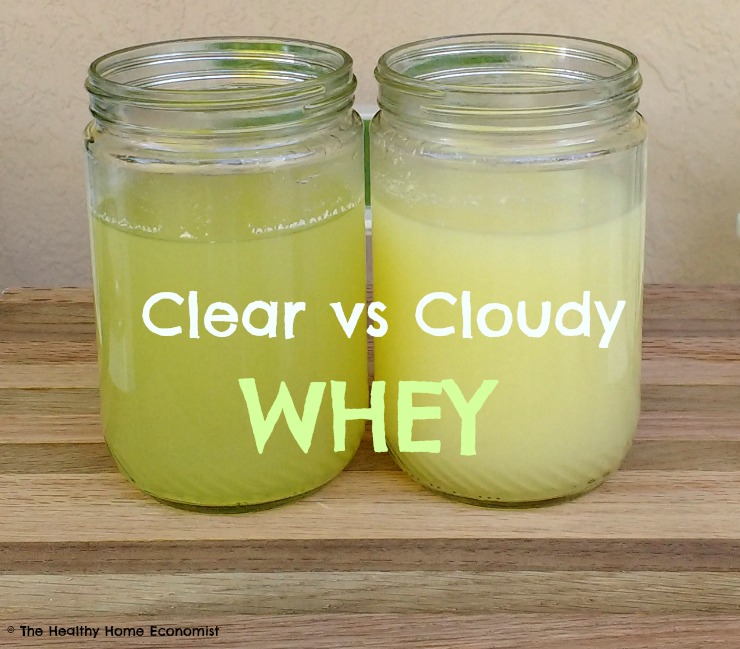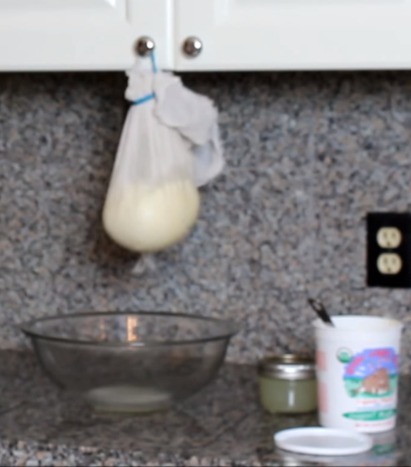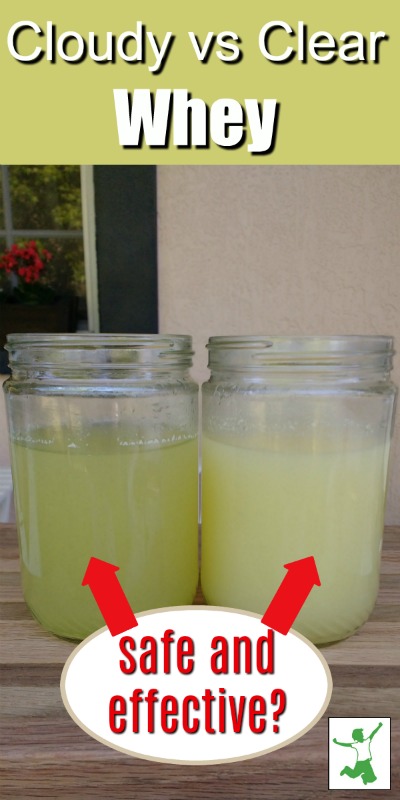
The clear liquid on the top of a newly opened container of plain yogurt is the first experience most people have with whey in its healthiest form.
This golden-colored liquid was recommended for consumption by ancient Greek physicians Galen and most especially Hippocrates, who famously said that “all disease begins in the gut”. A daily dose of the traditional elixir assisted with the restoration of health for those who suffered from gut imbalance and the myriad of illnesses that go along with it. In healthy individuals, whey helps to maintain a balanced internal ecosystem where beneficial rather than pathogenic microbes are in control of the intestinal environment.
In essence, whey was a type of traditional probiotic supplement used for many centuries before factory-produced versions came into vogue.
Whey in Traditional Cooking
Whey is commonly used as the probiotic-rich starter liquid for traditional fermentation recipes and for soaking legumes and grains before cooking to deactivate anti-nutrients, release valuable minerals, and improve digestibility.
It is also an important ingredient in a healthy baby formula recipe made with cow milk, goat milk, and a dairy-free baby formula recipe using bone broth made at home. Whey properly and carefully strained from fermented milk surprisingly does not contain any lactose and is therefore fine for many babies with a dairy intolerance.
Be advised that whey protein powder is never a healthy substitute for the real thing! Even when low temperature processed, protein powder tends to be high in (unlabeled) MSG, a residue from processing, and damaged proteins from powdering. This factory food masquerading as a health food has the potential to exacerbate autoimmune conditions or even trigger new ones over time if consumed on a regular basis.
Fortunately, people are figuring out that protein powder is not such a great idea and are turning to the liquid, whole-food versions naturally found in fermented dairy products like yogurt, kefir, and clabbered raw milk.
Making Liquid Whey (you will probably have to do it yourself)
The biggest problem with whey in its unprocessed form is that you can’t buy it at the store. Even (gasp) Whole Foods or Trader Joe’s don’t carry it.
If you’re lucky, a local raw dairy farm may have this nourishing golden liquid for sale (like mine!). Most of the time, you have to take the time to separate it yourself. This article has a recipe plus video on making raw whey. This article plus video describes the same process separating whey from yogurt. It’s an easy task, so don’t be put off by the DIY approach.
Note that whey leftover from cheesemaking is not the same as liquid separated from cultured dairy products. Cheese whey has been heated and hence has lost the probiotic and enzymatic components that are so beneficial to gut health. This is why it cannot be used for homemade formula either as it will curdle it. Cheese whey does contain many nutrients the same as its more beneficial cousin particularly potassium and vitamin B2 (1). For this reason, cheese whey makes excellent fertilizer for your backyard garden and will attract lots of worms that will improve the soil.
Whey that is Cloudy vs Clear
One of the most common problems people ask when they make liquid whey themselves for the first time is whether cloudy whey is as beneficial as clear, golden whey.
This is a very valid question. I have made whey well over 100 times and have never quite figured out exactly what causes one batch to be cloudy and the next batch clear.

One thing I have noticed is that the first bit of liquid whey separated from a fermented dairy product can frequently be cloudy while the rest will run clear. So, if cloudy whey bothers you, then simply swap a clean bowl underneath the hanging bag of fermented dairy as soon as you notice the liquid passing through the cheesecloth has become clear.
Otherwise, if you don’t have time to babysit the separation process, then rest assured that if the final product is cloudy, it isn’t a problem. It can still be used for fermentation purposes and for homemade baby formula.
Incidentally, the cloudiness is from residual casein milk proteins that escape through the cheesecloth.
Another way to obtain a clear end result is to put the jar full of cloudy whey in the refrigerator. As it settles out, you may notice the residual proteins collecting at the top. At that point, you can carefully lift off the milky white proteins with a slotted spoon or strain for a second time through a cheesecloth.

How To Enjoy the Benefits of Liquid Whey
If you love nourishing liquid whey as I do, perhaps you have wondered how to enjoy its benefits. Here are some great ideas from author Jen Allbritton to inspire you (2):
- Drink it straight or mix it in with a fermented beverage or tea (to add a probiotic boost).
- Freeze it into ice cubes and blend them into smoothies (instead of nasty protein powder!) for a more slushy texture or cool-down a beverage on a hot day.
- Replace a portion of the water used to cook grains.
- Include in the soaking water for legumes and grains to improve digestibility.
- Lacto-ferment almost anything – apples, zucchini, cabbage, cherry chutney, ginger carrots. The books Nourishing Traditions or Wild Fermentation have numerous recipes to choose from.
- Feed to pets – chickens, dogs, cats, they all can benefit from this nourishing liquid.
I also sometimes dilute it by 50% with some cold water, a squeeze of half a lemon or few ounces of orange juice, and a pinch of sea salt for an extremely hydrating, natural Gatorade on the go.








Thank you Sarah for the previous reply and great article.
Please could you share any info on how to follow the “Whey Cure” as it was used in the 18th century?
Thank you.
Never heard of the “whey cure”.
Hello.
Does heating raw liquid whey obtained from clabbered milk destroy the nutrition, enzymes etc in the whey like they are destroyed in raw milk if heated? Or is whey ok to heat and turn into powder form?
Thank you.
Heating whey above 118F completely destroys the probiotics and enzymes. Making it into a powder denatures the proteins to the point where it is no longer beneficial and actually detrimental to health to consume. Whey is very delicate!
Is there any way to make whey into a butter? I’m curious to find out. I don’t like drinking milk and I have made yogurt out of milk, and I was wondering if butter could possibly be made from the whey of it.
Whey cannot be made into butter. Butter is made by churning cream. https://www.thehealthyhomeeconomist.com/video-how-to-make-raw-butter/
Is the liquid in the bottom of a can of coconut milk coconut whey? Can I’d be used as kefir?
The liquid at the bottom of a can of coconut milk is NOT whey .. it is coconut water. Here is how to make coconut milk into kefir. https://www.thehealthyhomeeconomist.com/video-coconut-milk-kefir/
Great article, thank you. The whey I made from yogurt and stored in the fridge developed little things I best describe as cloud curds. Do you know if it is still healthy or if it is telling me good bye.
Thank you.
If it doesn’t have mold, it is almost certainly fine. The texture does sometimes change a bit when refrigerated.
Sarah what about liquid whey brand like Molkosan by Alfred Vogel. Molkoan is made from fresh whey by a special lactofermentation, concentration and pasteurisation process.
Does this have the same problems as the whey powders ?
I haven’t seen that brand of liquid whey anywhere where I live so I haven’t examined it personally. If it’s pasteurized, though, it is worthless as all the enzymes and probiotics are gone!
Similarly, whey protein powders are even more denatured and not a good idea to consume. https://www.thehealthyhomeeconomist.com/ditch-that-protein-powder/
After many years if making lebne ( kefer) I noticed as I hang the lebne ,any when that spills on the counter has cleaned the bottom of my copper pot with out scrubbing!
As this post is a couple months old, I’m hoping you’ll see this post, Sarah, and give your thoughts. Or if someone else has an opinion, please weigh in. I know that whey can last for months in the frig and that whey can be used to jumpstart the fermentation process with vegetables. However, there is one place online, by someone who has been fermenting vegetables for decades, where she says that if you’re going to use whey to ferment your vegetables, it should be fresh whey – not more than a week old. Now she doesn’t say why you shouldn’t use older whey, but I assume it would have something to do with all the ‘food’ being eaten up by the probiotic bacteria and, therefore, the older the whey, the fewer beneficial organisms left to ensure a successful ferment. Have you heard anything about not using an older whey in fermentation?
You can definitely use older whey in fermentation recipes. I do it all the time! My raw whey typically lasts several months in the refrigerator.
Do you ever use whey for soaking nuts? I usually just use salt in n the water.
I use salted water for soaking nuts.
Hi Sara,
I just want to clarify: Are you saying that even the process that Isagenix uses, a no heat micro-filtration process that does not use salt, acids or enzymes is a problem too?
I thought it was through heating that MSG is formed. Thank you for helping me out.
Susan
Yes, it’s still a problem when low heat is used. The powderization of the whey is an issue as well. The proteins in whey are extremely delicate.